If you're writing in a language other than English, you'll likely need to know how to include accent marks. You know, like voilà, olé, or über.
Fortunately, there are a couple easy ways to do this on a Mac. In this article, we'll go through the main methods so you can add accents to your text with ease.
The Press and Hold Accent Method on Mac
If you're not in a rush and you want to see all the common accent options at a glance, there's an easy way to do that.
Simply press and hold the key on which you'd like the accent to appear, and a number of options will come up above the letter, like this:
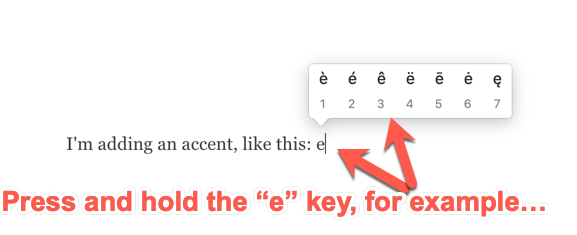
When you see the type of accent you'd like to add, just type that number and the accent will be added to the letter. You can also use the left and right arrow keys (and enter) to select which one you want.
So, for example, if you wanted the second option, above, you'd press and hold e, then press 2 (or press the right arrow key once and then enter).
This method works well if you don't mind the time it takes for that little accent menu to pop up. But it doesn't always include all accents in every language. And it does slow down your flow, especially if you're typing a whole article in another language. Whew, that's a lot of added time.
Fortunately, there's another common method that involves keyboard shortcuts. And gives you all the options, as well.
The Option Key Accent Method on Mac
The Option key helps you add all kinds of accent and diacritic marks to your text. Just press and hold the Option key (the same as the Alt key), then press the "e" key, and then release them and press the letter key to which you'd like to add the accent.
For example, if you'd like to add an acute accent (´) to the letters a, e, i, o, or u, you'd press Option + e, and then the letter to which you'd like to add the accent. So, Option+e+a gets you á.
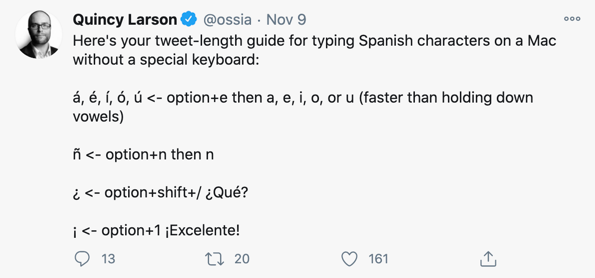
But what if you want a different sort of accent, like a grave or umlaut? Don't worry – there are option key combos for those, too (and more).
- Option + ` + letter = grave accent à, è, ì, ò, or ù (like this: Voilà)
- Option + i + letter = circumflex accent â, ê, î, ô, or û (like this: Crêpe)
- Option + n + letter = eñe character ñ, ã, or õ (like this: El Niño)
- Option + u + letter = umlaut accent ä, ë, ï, ö, or ü (like this: Über)
- Option + a or Shift + Option + A (for capital A) = å or Å
- Option + ' or Shift + Option + ' = æ or Æ (ligatured ae)
- Option + q or Shift + Option + Q (for capital letters) = œ or Œ
- Option + c or Shift + Option + C (for capital) = ç or Ç
- Option + o or Shift + Option + O (for capital) = ø or Ø
- Shift + Option + ? = ¿
- Option + 1 = ¡
- Option + 5 = ∞
Once you memorize these combinations, you can incorporate the keystrokes right into your typical typing flow. And you can always bookmark this article in case you forget :).
Bonus: Other Option Key combos on Mac
What if you need to type some math symbols? Or the symbol for the Euro currency? You'll need more than just accent options.
Well, did you know – your basic English-language keyboard is hiding all those special characters right in (almost) plain sight?
By holding the option key and pressing any of the letters/numbers/punctuation marks, you can create a completely different character than what's printed on your keyboard.
So how do you know what each key combo gets you? Don't worry – your Mac can tell you. It just takes a few steps to find that info.
Step 1: Go to System Preferences
Find the Apple icon in the upper left corner, and click it. Then select "System Preferences" from the dropdown menu.
Select the Keyboard icon, and you'll see this box:
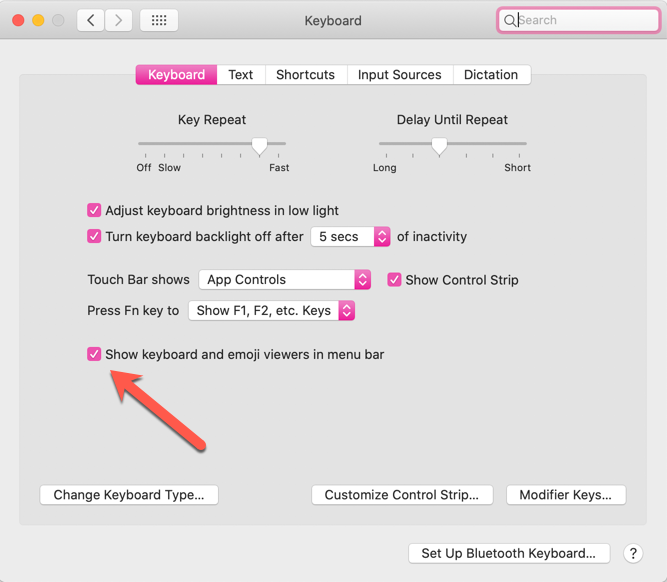
Make sure the "Show keyboard and emoji viewers in menu bar" is checked (as it is in the image above).
Step 2: Click the keyboard icon in your top menu bar
Now you'll see a little keyboard icon in your top menu bar, next to your bluetooth and wifi symbols/icons. Click it, and select "Show keyboard viewer".
That will bring up an image of your keyboard as it's configured on your Mac:
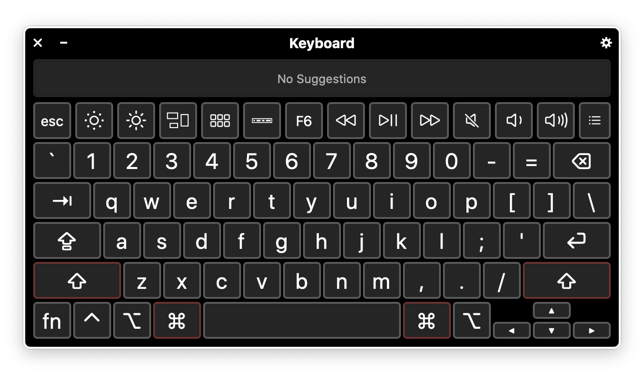
Step 3: Press the Options key
Now, if you hold down the Options key, it'll show you what else all those keys can do, like this:
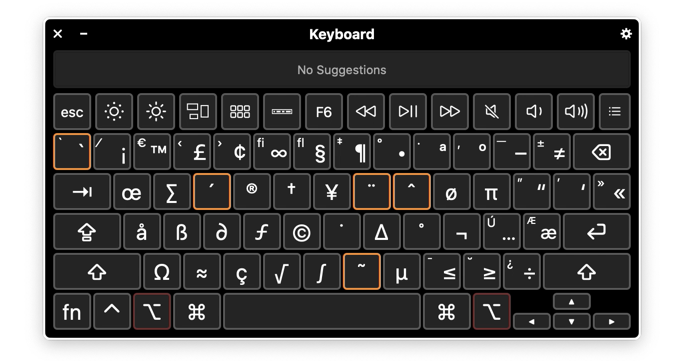
You can see the most common accent marks highlighted in orange above. Those are the keys that, when combined with the Option key, give you those accent marks (as you learned above).
You'll also see all kinds of other useful symbols, like currency symbols, math symbols, and so on. So if you ever need a quick reminder about what keys to press when you need to write the Greek letter µ (miu), for example, just reference this chart.
How to Add Accents on Windows with the International Keyboard
If you want to use shortcuts to include accents and special characters without switching to an entirely different keyboard layout, you can enable the international keyboard.
First, press the Windows key, type "Language", and click on "Language Settings" to open the language menu:

Then under "Preferred languages" click on "English" and "Options" to open the language options menu:

Under "Keyboards", click the "Add a keyboard" button and click on "United States-International" to add the international keyboard to your system.
To enable the international keyboard, move your mouse down to the taskbar and click on "ENG US", then click on "ENG INTL":

Alternatively, hold down the Windows key and press Space to cycle through your installed keyboard layouts.
The main difference between the normal US keyboard layout and the international layout is that some keys work as a sort of "accented character lock".
For example, to type a single apostrophe (') with the international keyboard enabled, just type ' + Space. For a double quotation mark, just type " + Space. And backticks work the same way with ` + Space.
With that out of the way, here's how to type some common accents with the Windows 10 international keyboard:
- ` + letter = grave accent à, è, ì, ò, or ù (like this: Voilà)
- ^ + letter = circumflex accent â, ê, î, ô, or û (like this: Crêpe)
- ~ + letter = eñe character ñ, ã, or õ (like this: El Niño)
- " + letter = umlaut accent ä, ë, ï, ö, or ü (like this: Über)
- Right Alt+ w or Shift + Right Alt + W (for capital A) = å or Å
- Right Alt + z or Shift + Right Alt + Z = æ or Æ (ligatured ae)
- Right Alt + < or Shift + Right Alt + < (for capital) = ç or Ç
- Right Alt + l or Shift + Right Alt + L (for capital) = ø or Ø
- Right Alt + ? = ¿
- Right Alt + 1 = ¡
But you might have noticed that there's no shortcut to type œ, Œ, or ∞ with the international keyboard.
For that, let's take a quick look at another way to type accents, special characters, and symbols on Windows 10.
How to Add Accents on Windows with the Emoji Panel
The emoji panel makes it easy to scroll through all the available emoji and add one to a message. But you can also use the emoji panel to quickly add an accented or special character, too.
Use the shortcut Windows Key + . to open the emoji panel:

To add accents or special characters, press the symbols button at the top:

Then scroll through the menu and click on the accent or character you want:

Also, you can click around the different menus at the bottom for different types of symbols. For example, ∞ is in the "Math symbols" section:

And that should be everything you need to know to type accents and other special characters on both Mac and Windows. Adiós!

